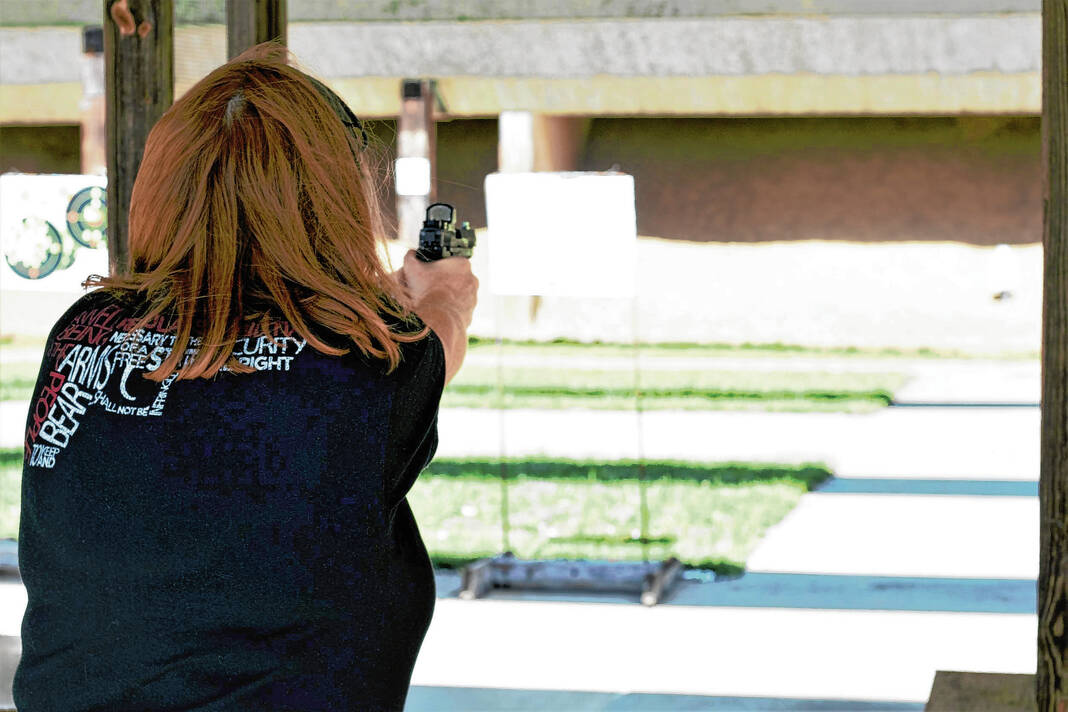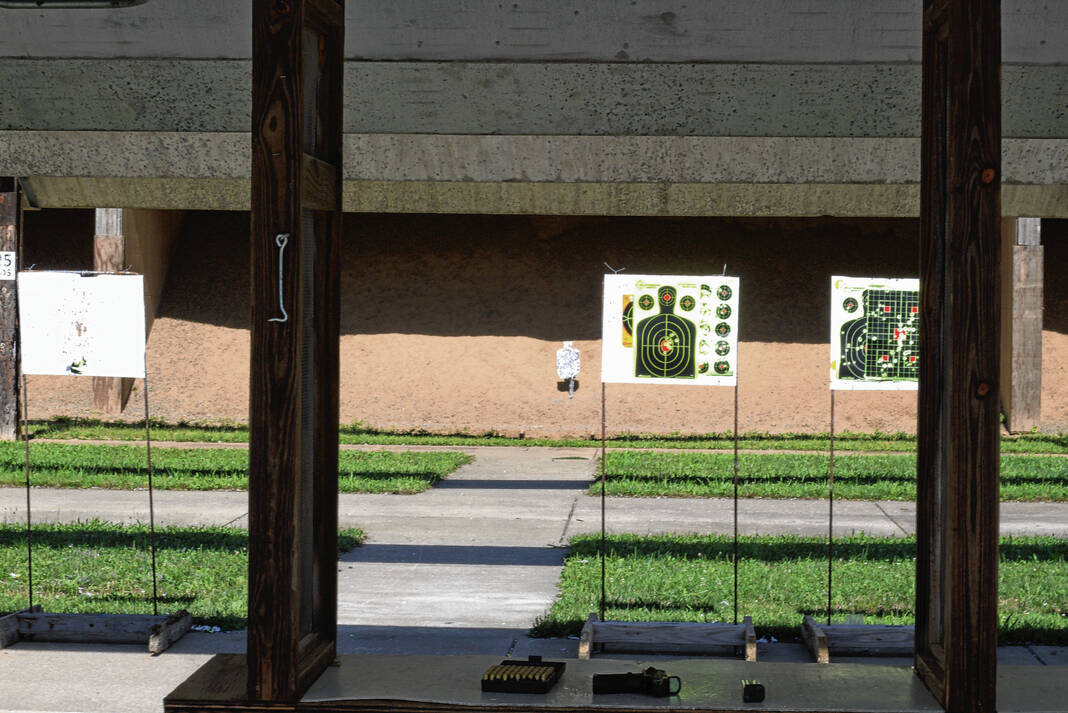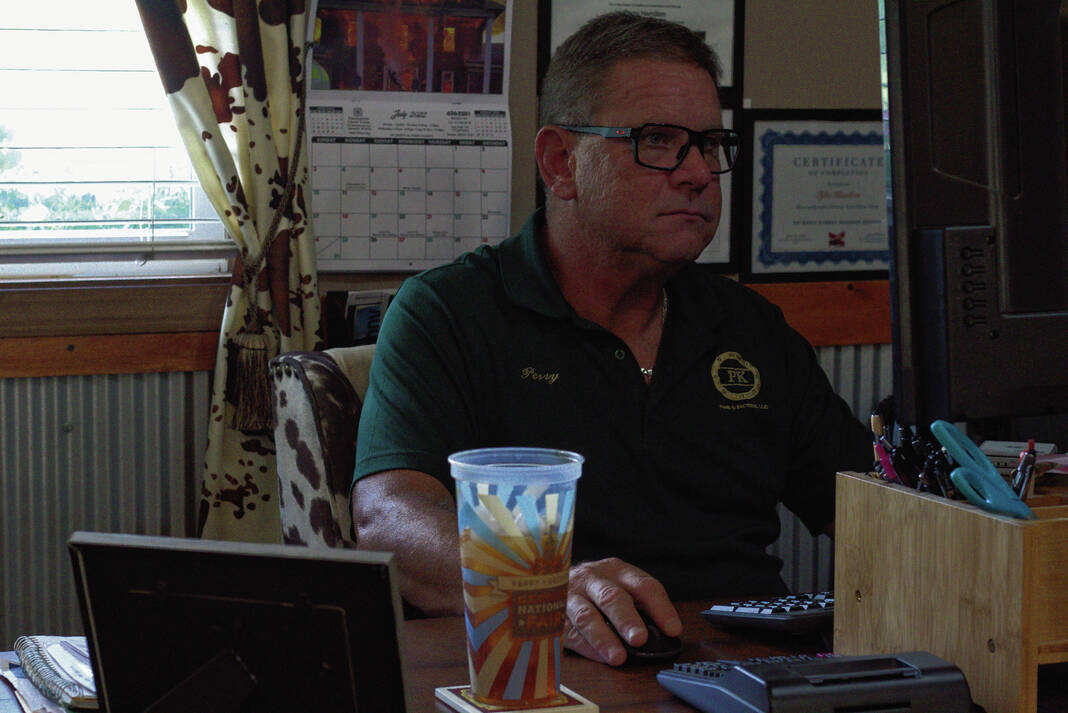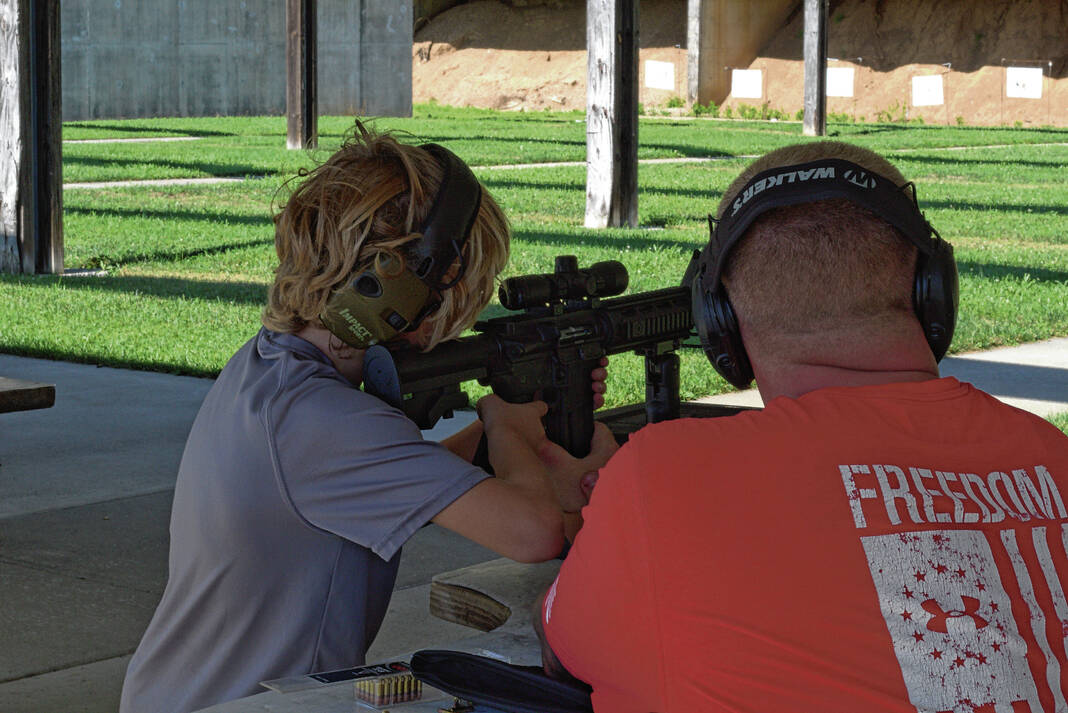Local firearm trainers say they have noticed new interest from people wanting to own and learn how to use a gun in the last couple of weeks.
Interest has peaked in the wake of Indiana’s constitutional carry law going into effect July 1, which allows citizens in the state to carry a firearm without a permit, and the July 17 mass shooting at the Greenwood Park Mall where an armed bystander took down the gunman.
Jeff and Tina Hopson, husband and wife and owners of Hoosier Bullets and Training in Trafalgar, have noticed an uptick in class interest for those reasons, they said. They are both National Rifle Association (NRA) certified trainers who offer classes from first steps to owning a firearm to defensive pistol training.
“We’re seeing our class sizes right now have doubled what they were three months ago,” Jeff Hopson said.
They have also heard from people specifically wanting to learn because of the Greenwood Park Mall shooting, including a couple of people who were there that day, he said.
Perry Hamilton, the owner of PK Arms and Tactical in Franklin, has also noticed a similar trend. Hamilton, an NRA and a U.S. Concealed Carry Association certified trainer, offers classes for all levels at his store in rural Franklin.
He thinks the increased interest is more of an effect of the Greenwood Park Mall shooting than permitless carry going into effect, he said. The mass shooting at the mall was something people did not think would happen here, he said.
“This has opened a lot of people’s eyes about what can happen, and I think a lot of people just want to protect themselves,” Hamilton said.
More goes into just owning a gun
Indiana does not have a training requirement to own a firearm, though experts say training is crucial for safety and to know how to use the weapon you want to own. That can be done by either taking professional classes or learning from someone you know who has training.
“They need to find somebody that knows how to shoot to teach them how,” Jeff Hopson said.
For first-time gun owners, or people interested in buying one, Jeff and Tina Hopson teach an NRA First Steps class. There, they use fake guns to teach people the basic safety of handling a firearm. They also will train people interested in buying a firearm to shoot with different types of guns to learn which one is best for them.
“Probably the biggest thing (to know) would be is to try different ones before you buy one … especially if you’re carrying it with you,” Jeff Hopson said. “You wouldn’t go and buy a car without test driving it.”
In addition to First Steps, the Hopsons teach basic pistol training classes and defensive pistol training classes, where people can learn to move while shooting and how to use cover, for example. Tina Hopson also teaches a women’s only class, as many women are becoming more interested in owning and learning how to use firearms, they said.
Hamilton, at his shop, also teaches basic handgun defensive shooting, concealed carry and home defense. He has four classes scheduled for this month, and spots are filling up, he said.
Hamilton also sells firearms. He performs background checks on customers and has turned a few people away who could not own a firearm under both Indiana and federal law.
“There was a lot of talk that anybody’s going to be able to run around carrying, and nothing could be further from the truth,” Hamilton said. “When we had the permit system, if you were a prohibited person, you were a prohibited person, and with that nothing’s changed.”
Those prohibited persons include people with a felony conviction, who face a restraining order or have a dangerous mental illness. Particularly when it comes to mental health, Johnson County law enforcement are doing the best they can to work on the mental health aspect through programs such as the county’s Crisis Intervention Team training. Law enforcement officers are also trying to document the health issues in their shared computer system, said Johnson County Sheriff Duane Burgess.
Law enforcement also utilize the state’s Red Flag law as another measure to prevent those who shouldn’t have guns from having them. Under the law, police may seize guns with or without a warrant, but those seized without a warrant are subject to a hearing where prosecutors are required to provide clear and convincing evidence beyond a reasonable doubt that the person is dangerous.
The Red Flag law has been utilized in Johnson County at least 14 times since it was first enacted. Locally, police are given 48 hours to file a probable cause affidavit with the county prosecutor’s office. The documents are then filed with the clerk of courts, and a hearing is set within 14 days of its receipt, Prosecutor Joe Villanueva told the Daily Journal last year.
While the law may need some work, police should utilize it when they need to, Burgess said
“We have one of the best red flag laws in the United States,” he said.
Mall incident a difficult shot
Elisjsah “Eli” Dicken, a 22-year-old from Seymour, was the armed bystander who took down the shooter at the Greenwood Park Mall within 15 seconds. Police said Dicken, who was carrying a pistol, fired 10 shots at the shooter from 40 yards away and hit him eight times.
That shot was difficult and nothing short of incredible, Jeff and Tina Hopson said. Most gun owners, even some professionals, would not try to take a shot like that from that distance, Jeff Hopson said.
“People don’t understand how really, he was highly skilled, to be honest with you,” Jeff Hopson said. “And very few people have that natural talent.”
At the Atterbury Shooting Complex in Edinburgh, which is open to the public and where Jeff and Tina Hopson will teach classes, they have a target set up at about 40 yards distance called “the Eli,” after Dicken.
Jeff and Tina Hopson said they can hit the target, as they are trained professionals, but noted it is still difficult to hit. Hitting a target is also a different situation than being in a mass shooting setting.
“We are very experienced shooters, so we can hit that. But there’s no pressure on us to hit that,” Tina Hopson said.
Drills are also being added to defense classes named after Dicken, where people are practicing how to shoot at further distances to prepare for an instance like what happened at the mall.
Risks exist for armed bystanders
In situations where an armed bystander has shot an active shooter, it can be difficult for officers to know who is the threat amid the chaos of a mass shooting.
“It’s very difficult in that situation,” Burgess said.
Last year, an armed bystander in suburban Denver shot and killed a gunman who had ambushed and fatally shot a police officer only to be killed himself by another officer who mistook him for the gunman. An investigation later cleared the officer who shot the armed bystander. The district attorney, who along with police has praised the armed bystander’s actions, said that the officer thought the armed bystander was a second active shooter and that he only had a moment to stop him from hurting others, the Associated Press reported.
In case of what happened at the Greenwood mall, Dicken immediately told mall security what he had done, and they relayed it to police, officials said. Dicken did everything appropriately, Burgess said.
“(Officers) could quickly determine he was not the active shooter,” he said.
Training and safety are key
Everyone has the right to protect themselves and protect others, and Dicken’s actions on that day protected a lot of people and saved lives, Burgess said. In active shooter situations, everyone is at risk, and most active shooters are not going to be selective with who they shoot at, said Matt Fillenwarth, Greenwood assistant chief of police.
The armed bystander had some firearm training, which helped in that situation. People should know what to do when carrying and they need to be educated about both that and the gun they do end up carrying. Getting educated is one of the most important things someone can do, Burgess said.
“Just buying a handgun and getting a box of shells is irresponsible … You need to get training,” Burgess said.
When people carry a weapon, they need to carry it responsibly. Whenever Burgess is off-duty, he still carries his weapon, but it is concealed. He does this because if an incident does arise, people need to have an element of surprise, he said.
“Not in every situation can you get a gun out in a crowded area,” Burgess said. “We have to know what the target is.”
Openly carrying a weapon can also make some people nervous, he said.
Safety and training are key. If someone does decide to carry a firearm, they should make sure to carry it in a quality, safe holster, Fillenwarth said. He has been a firearm training instructor for police for the last 25 years.
“If you plan on carrying it, you should take some classes or training to be familiar with that gun and be familiar and use it in a safe manner,” he said.
Two separate incidents of someone accidentally shooting themself in public were reported in 2021. Both incidents took place at the Greenwood mall.
In the first incident, a man accidentally shot himself in the leg outside PacSun. He was carrying a gun in his pocket, and not in a holster, when it accidentally went off. In the second incident, a teenager also accidentally shot himself in the leg, this time outside of the mall. He was carrying a gun in his waistband when it accidentally went off.
If someone is not familiar with a firearm, Fillenwarth recommends they take an NRA-approved gun safety class. They should also train and practice with the firearm if they are planning to carry, he said.
“If you take an NRA-approved course, you are guaranteed it’s going to be quality and you’re going to learn the basics,” Fillenwarth said.
If someone is going to carry a gun outside the home, they should make sure to familiarize and educate themselves on the laws governing self-defense, Fillenwarth said. Under Indiana law, a person is justified in using deadly force and does not have a duty to retreat if the person reasonably believes that force is necessary to prevent serious bodily injury to the person or a third party or the commission of a forcible felony, the law says.
Shooting a ‘perishable’ skill
Even experienced gun owners should continue to train, as shooting is a perishable skill. Jeff Hopson recommends visiting a range a couple times a month.
Hamilton echoed the sentiment and said he offers to let people come back to shoot at his range after taking his classes.
“There’s a lot to it, to shoot well. I mean, anybody can pull a trigger. But to shoot well, and remember your safety fundamentals and the firing fundamentals you have to train,” Hamilton said.
There is also mental training that goes into carrying a firearm. One of the first questions a gun owner should ask is, “am I willing to use this?” Jeff Hopson said. Teaching awareness is also part of their classes, he said. Being aware of surroundings and de-escalating situations are skills needed to carry a firearm.
“The best fight is the one that you avoid,” Jeff Hopson said. “The last thing you want is someone with a really crazy attitude to have a gun … You can learn when to swallow your pride and walk away.”
Daily Journal Multimedia News Editor Emily Ketterer and reporter Noah Crenshaw wrote this report.











